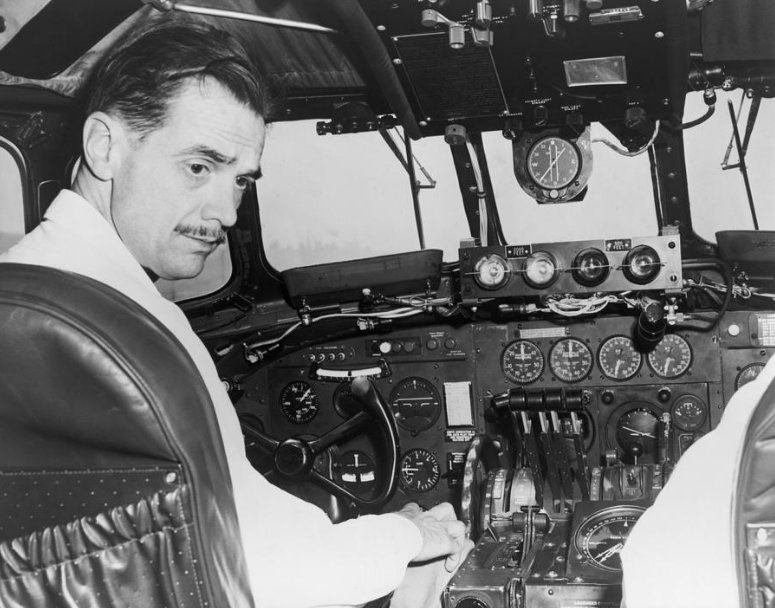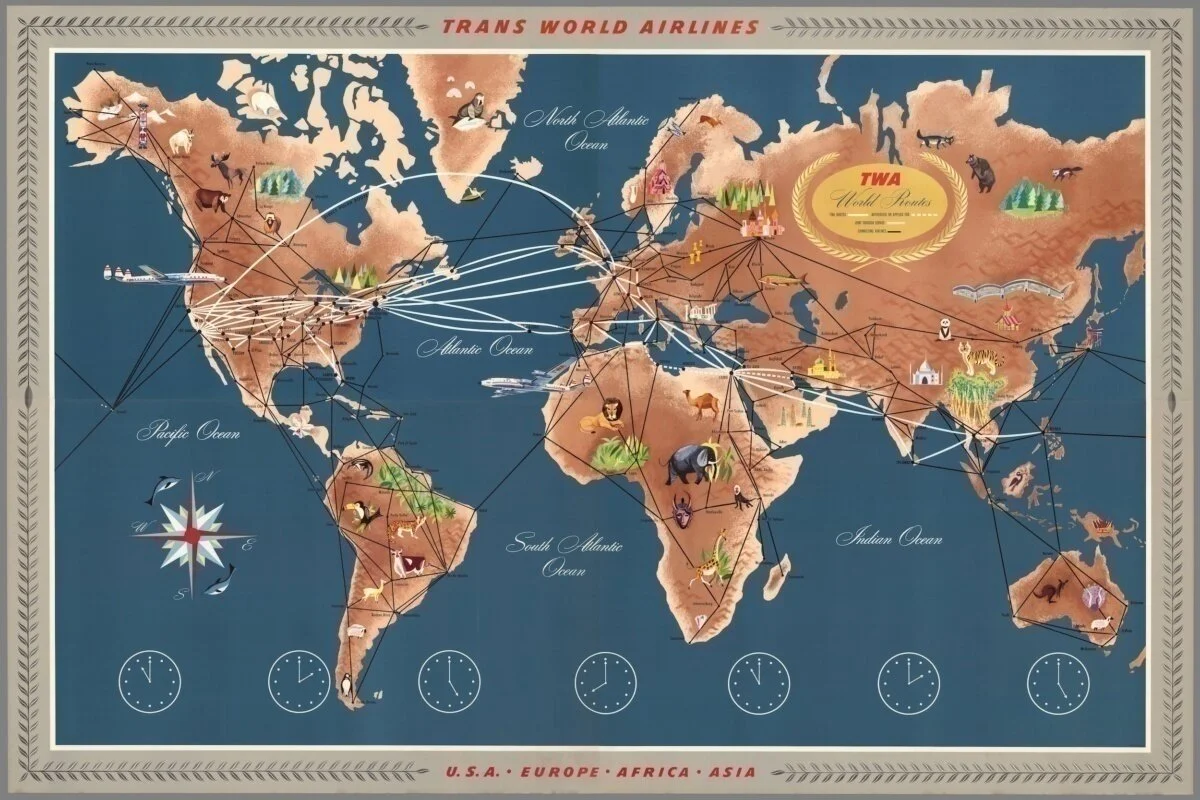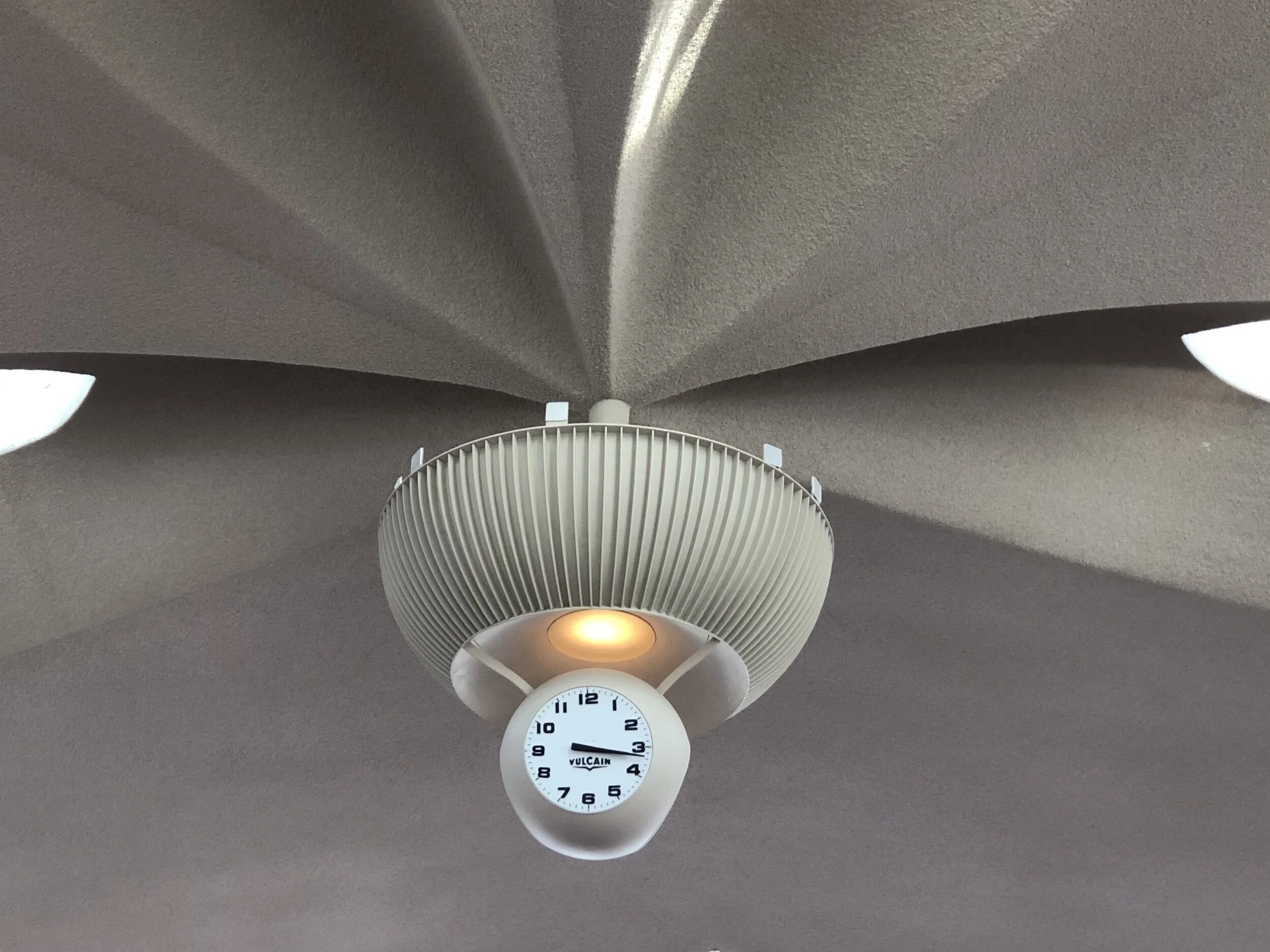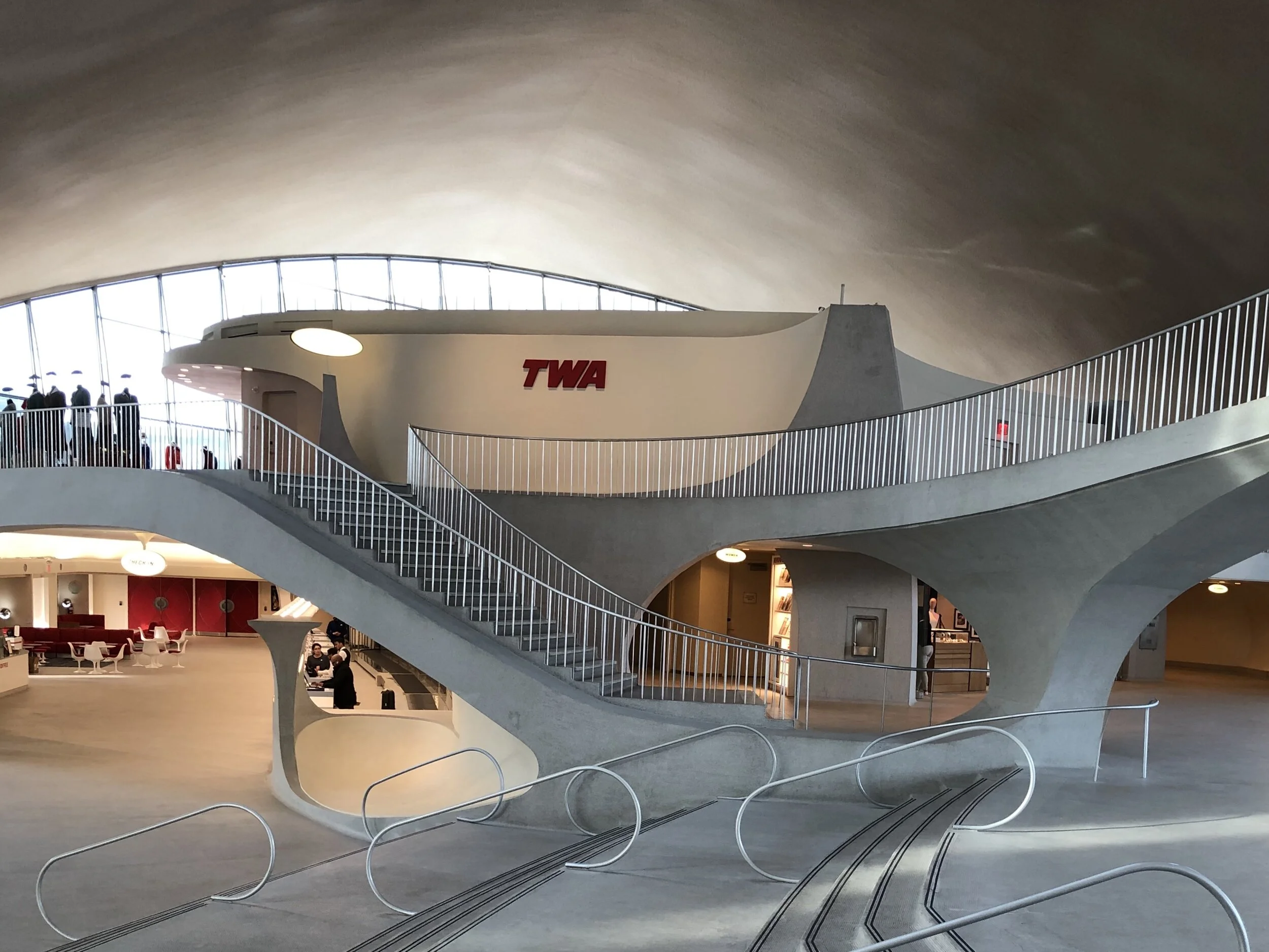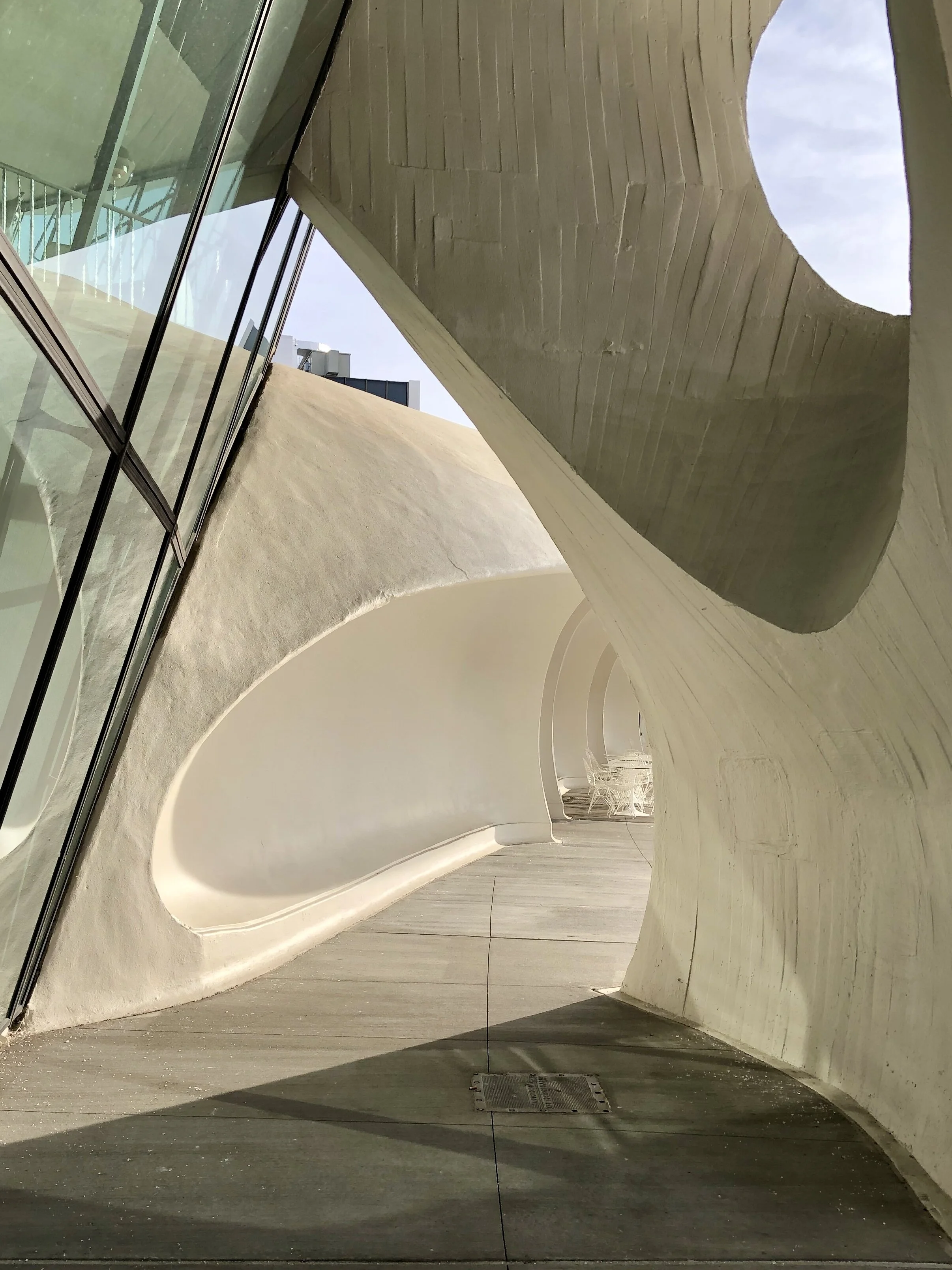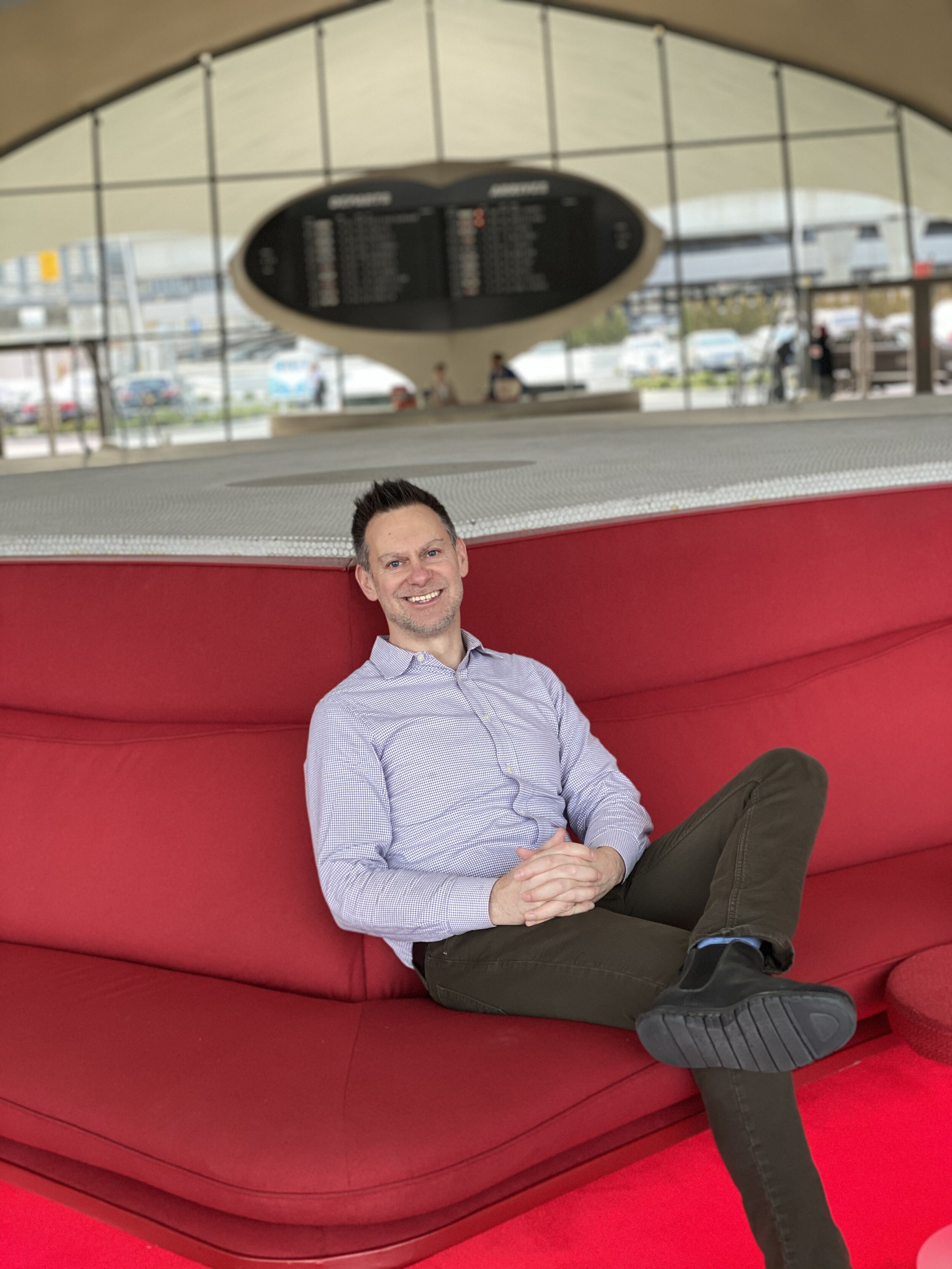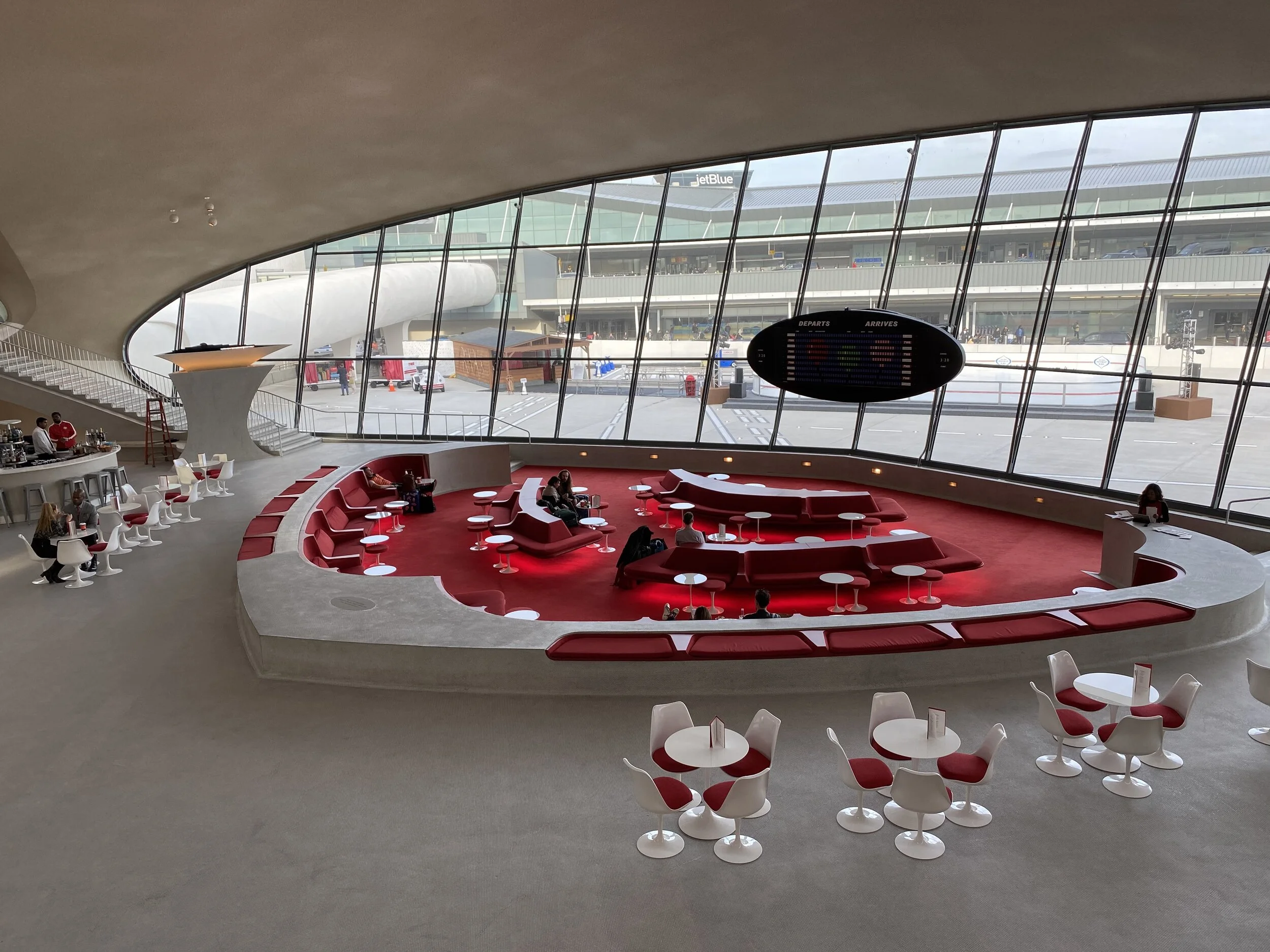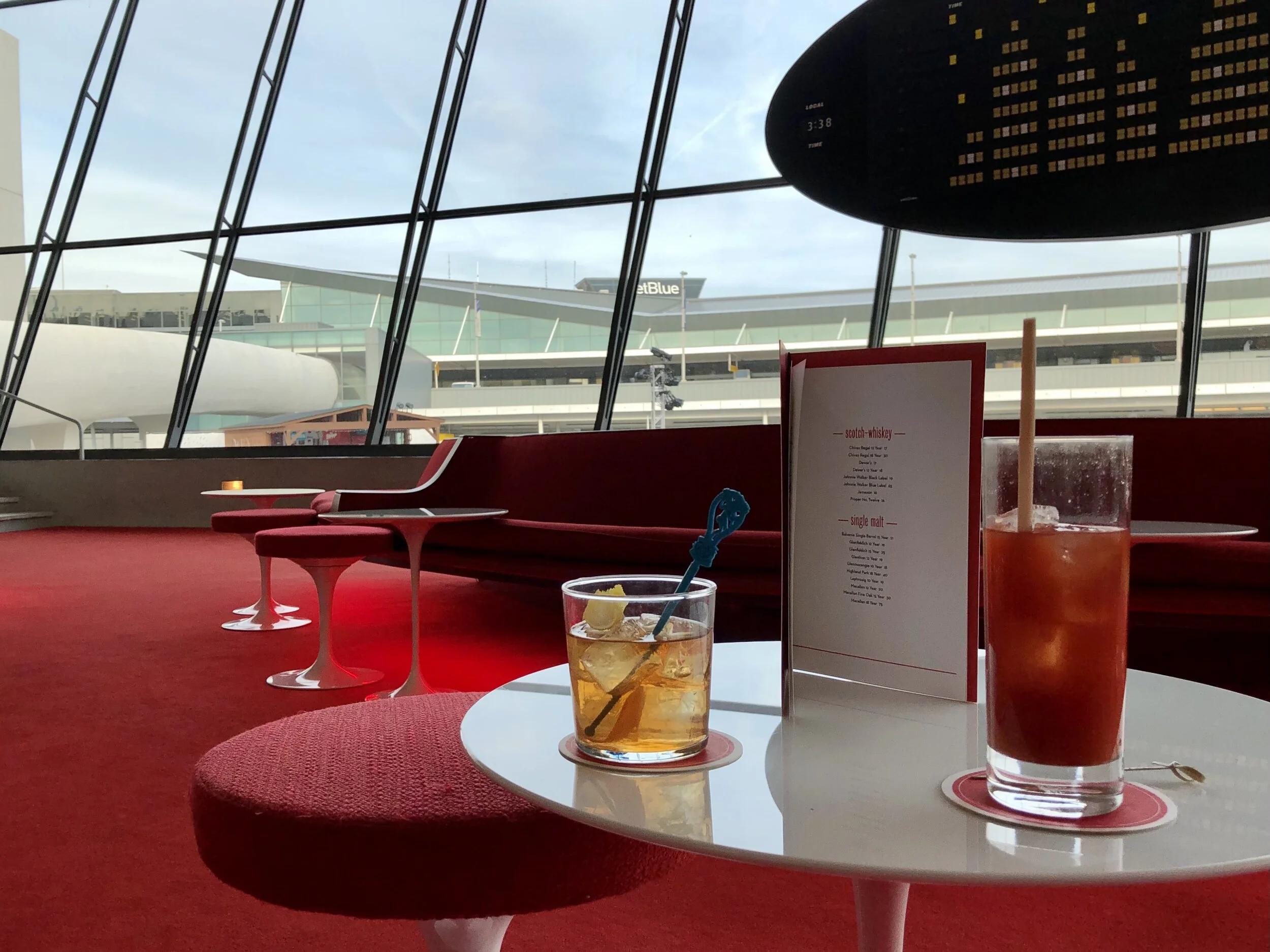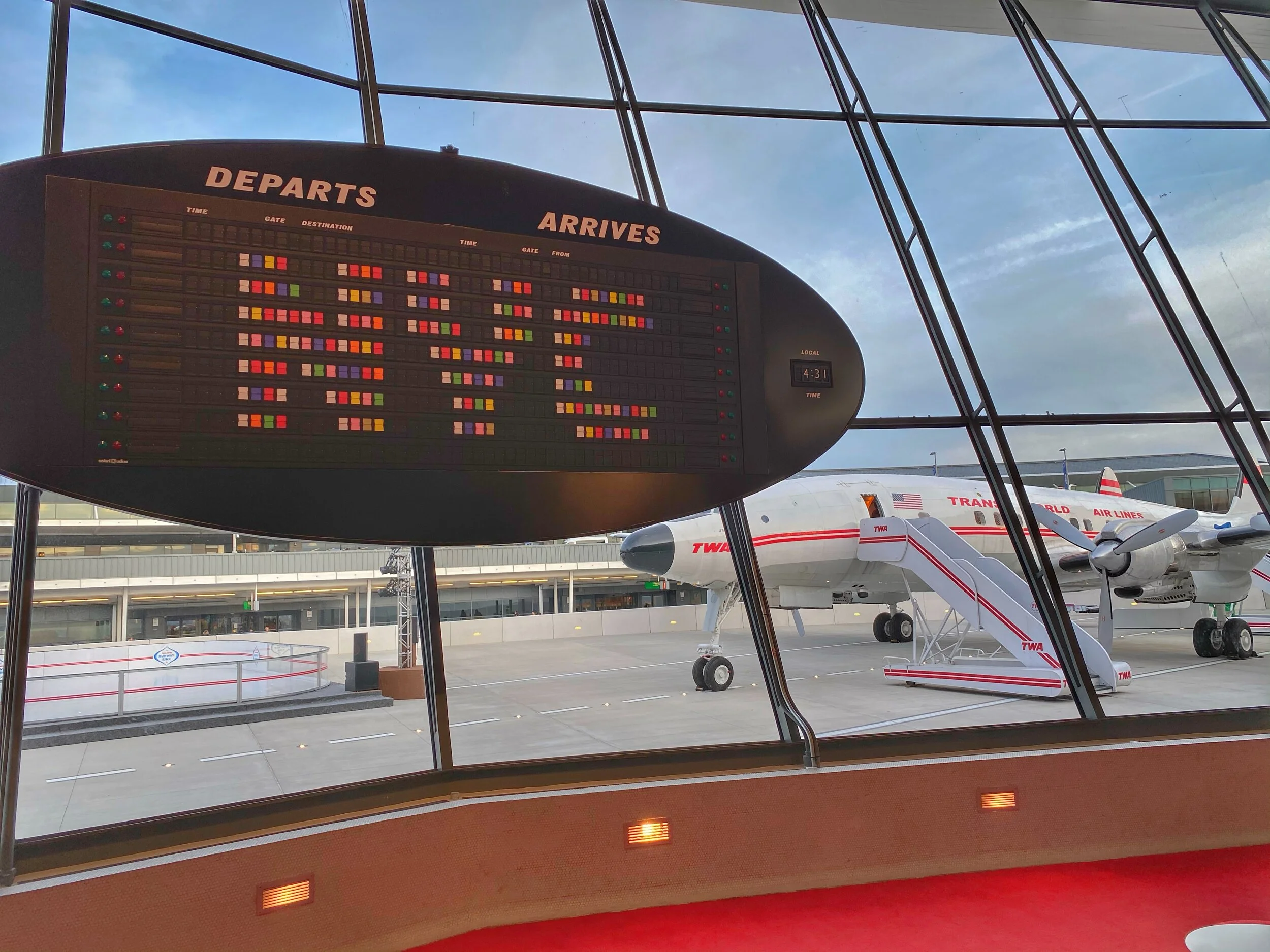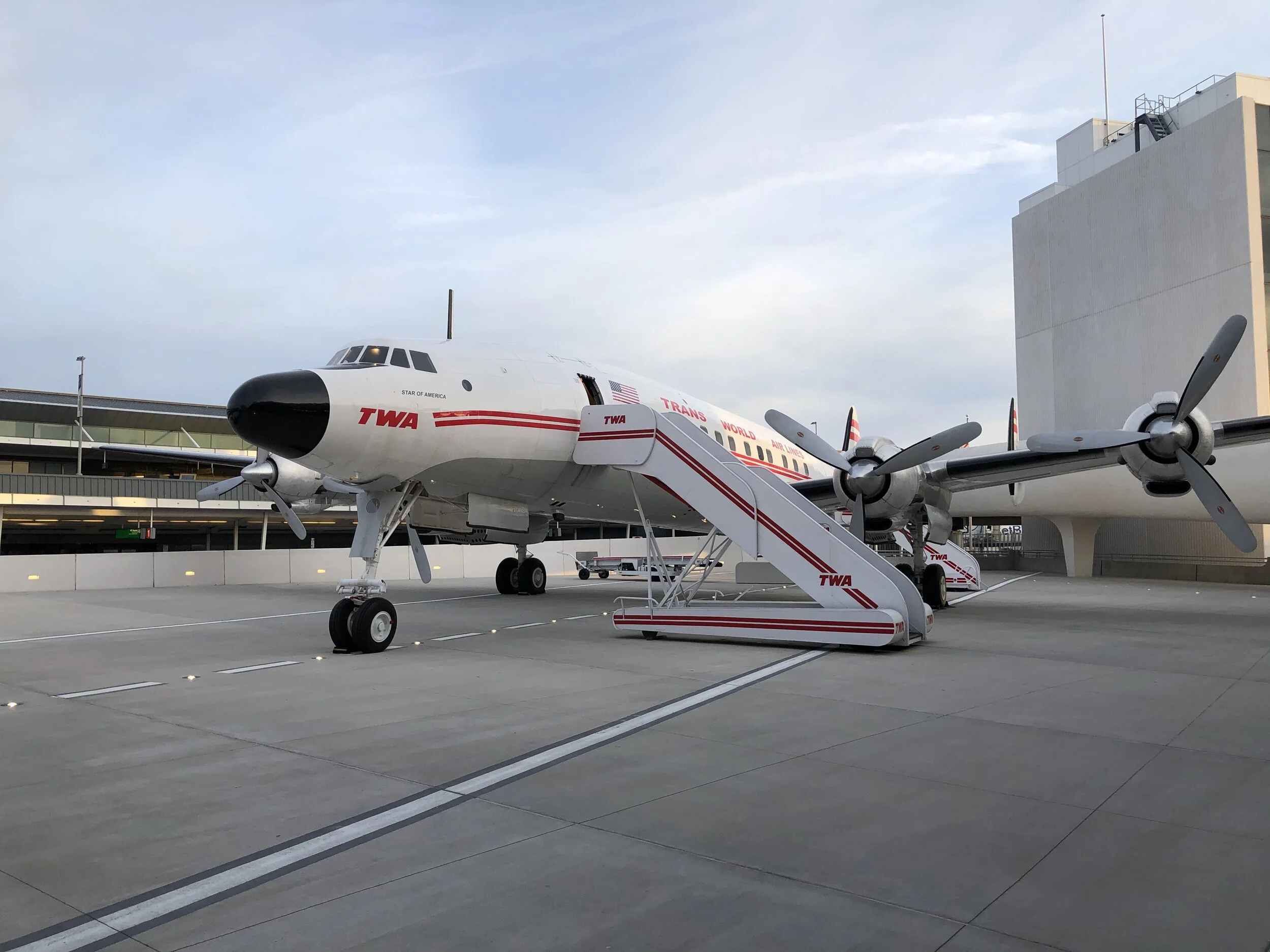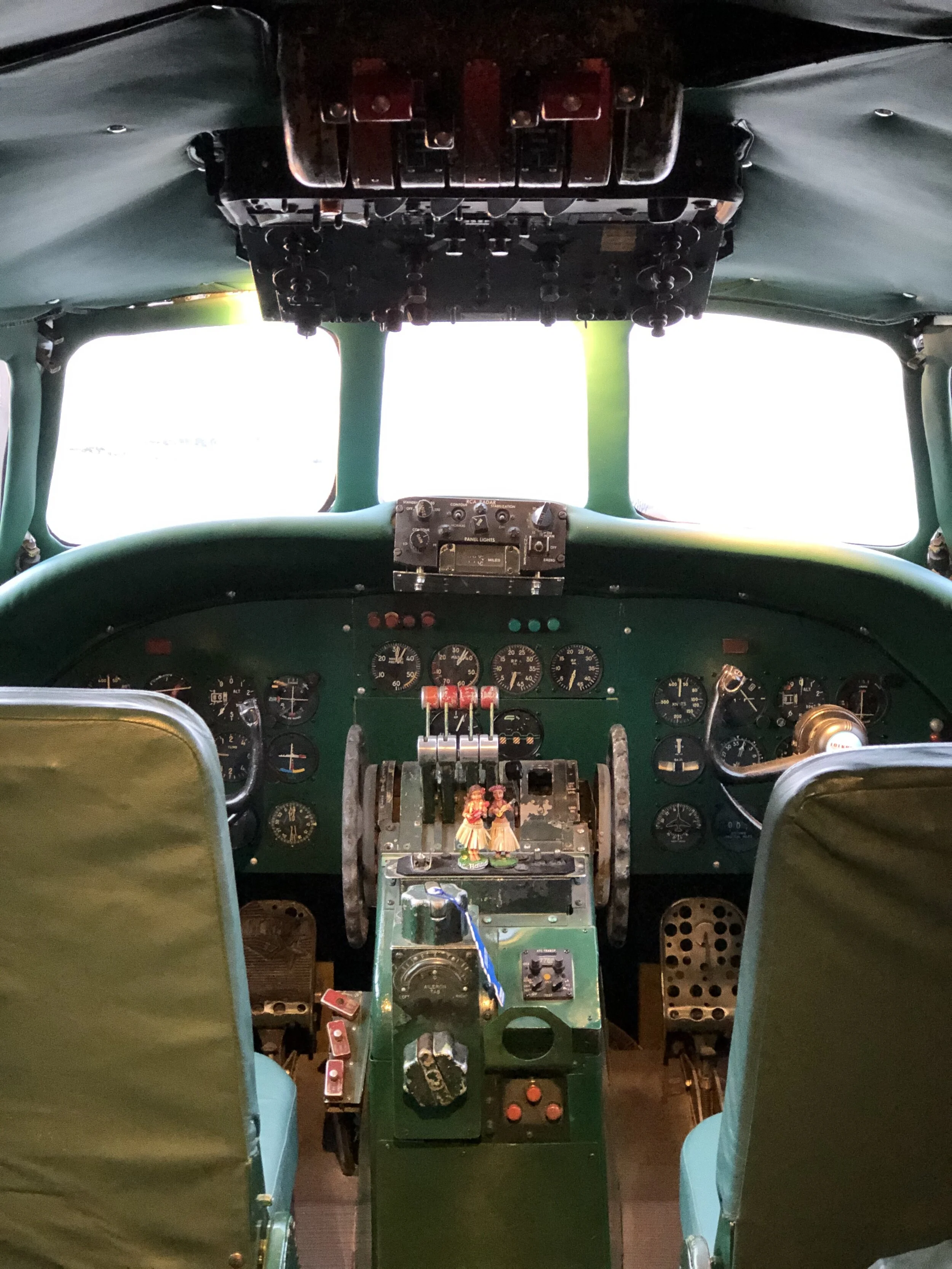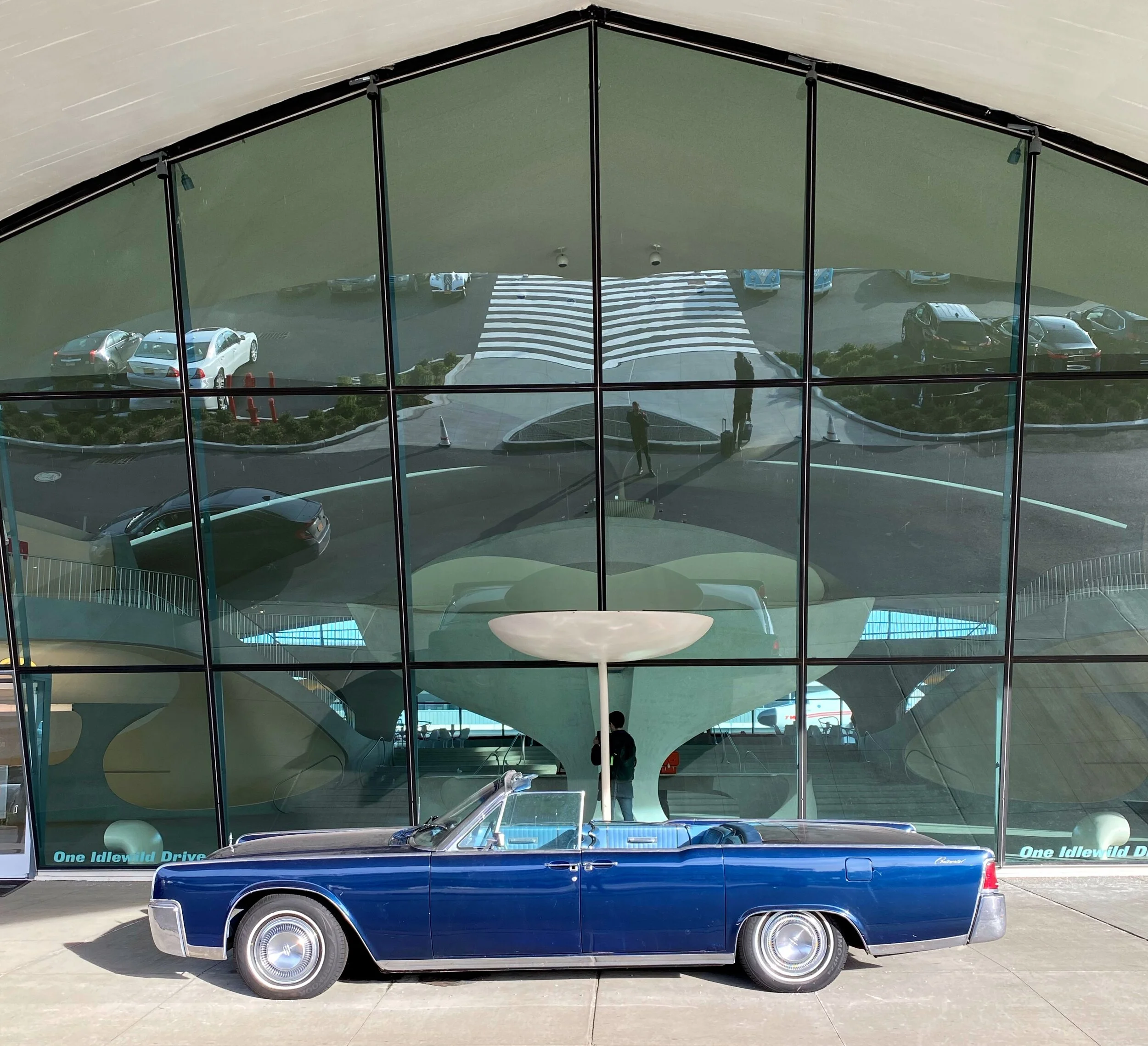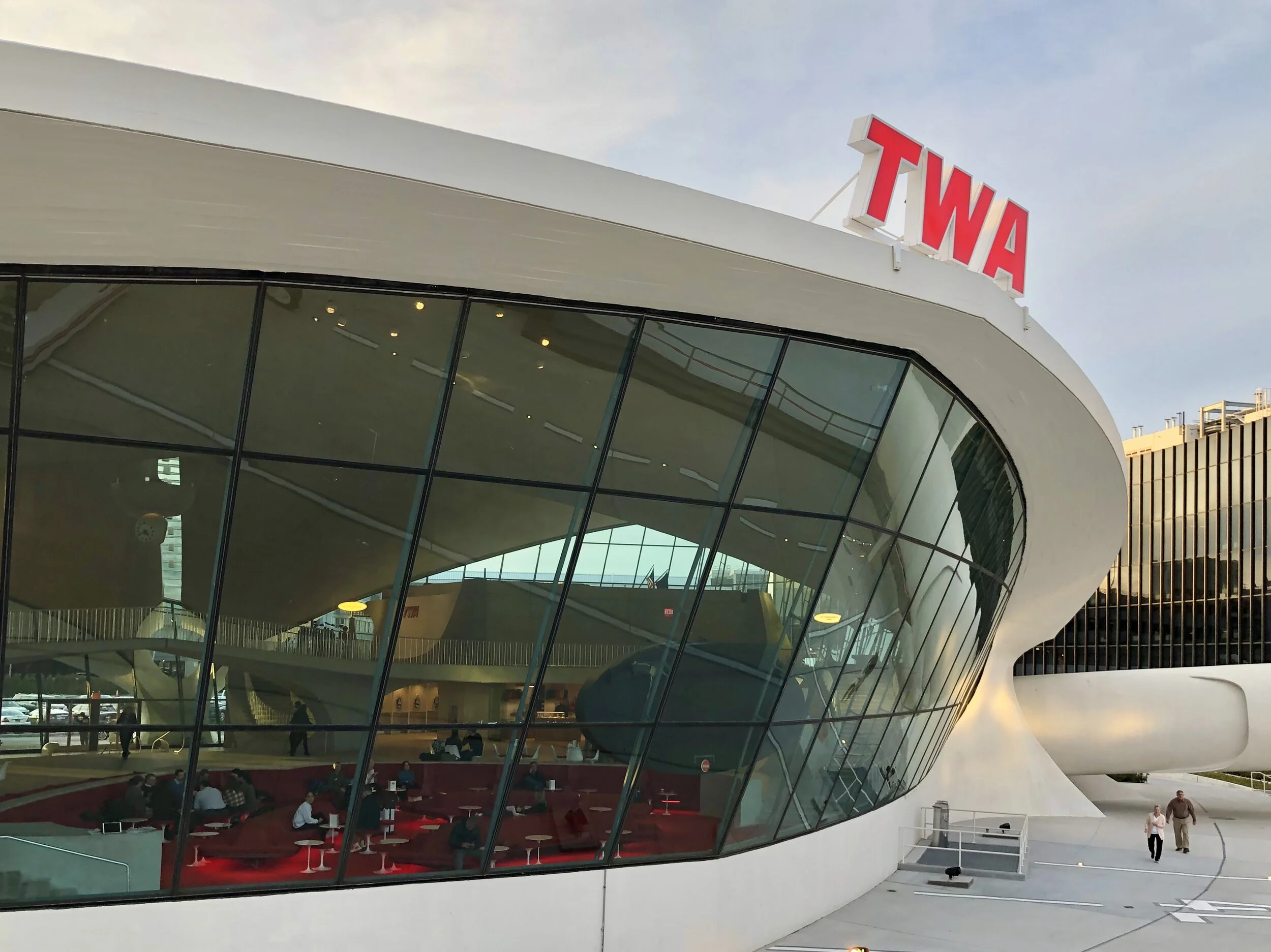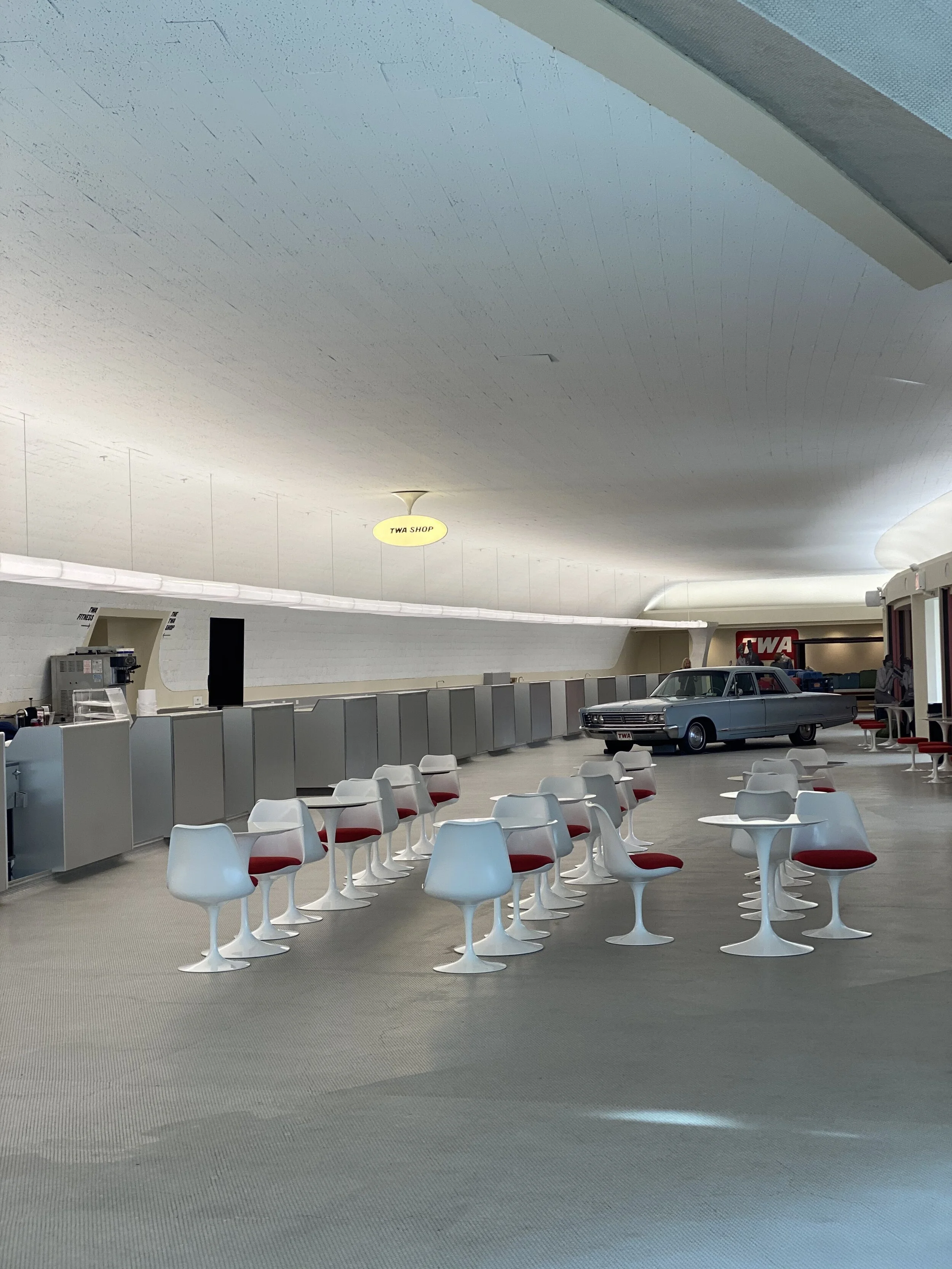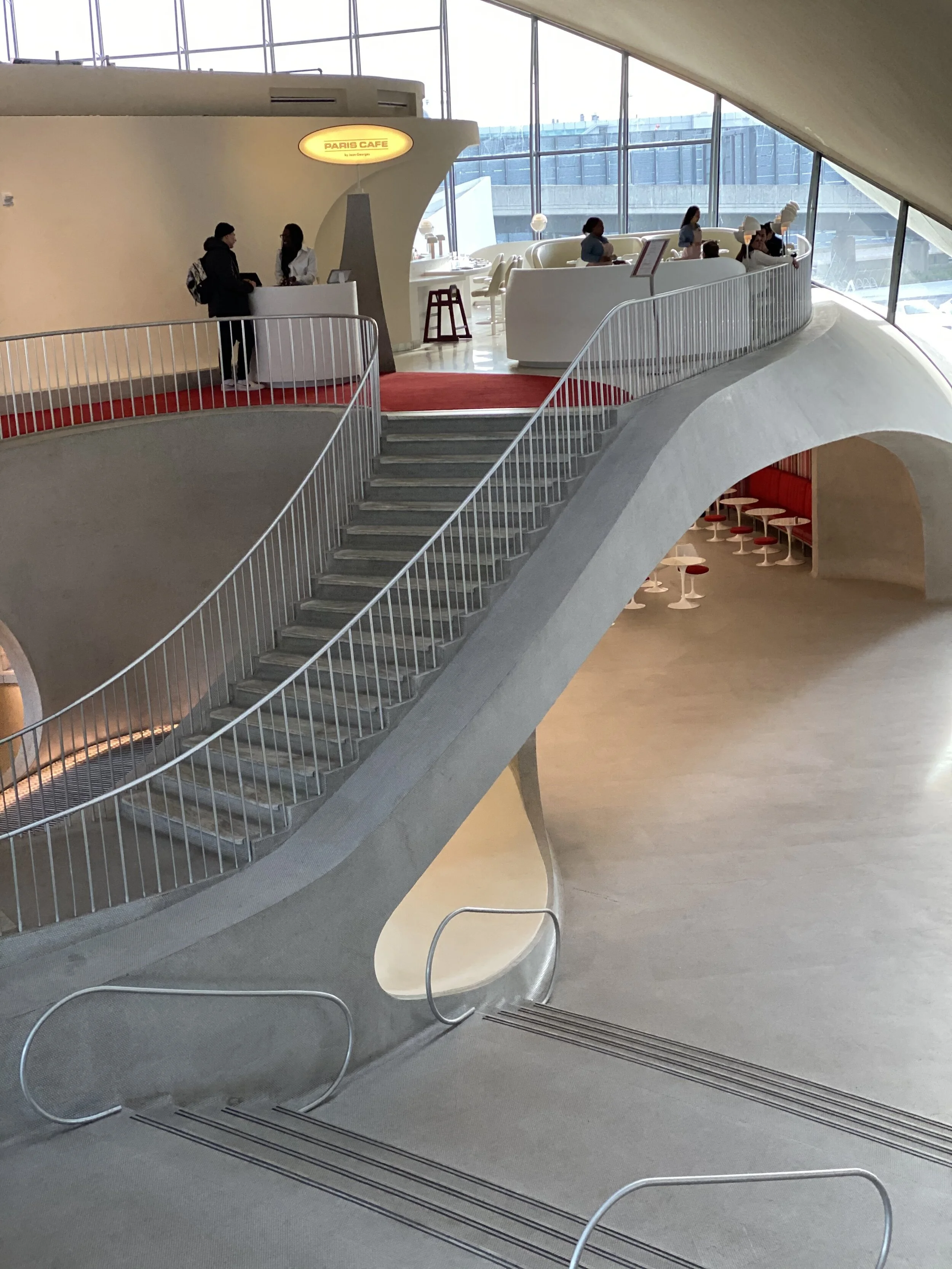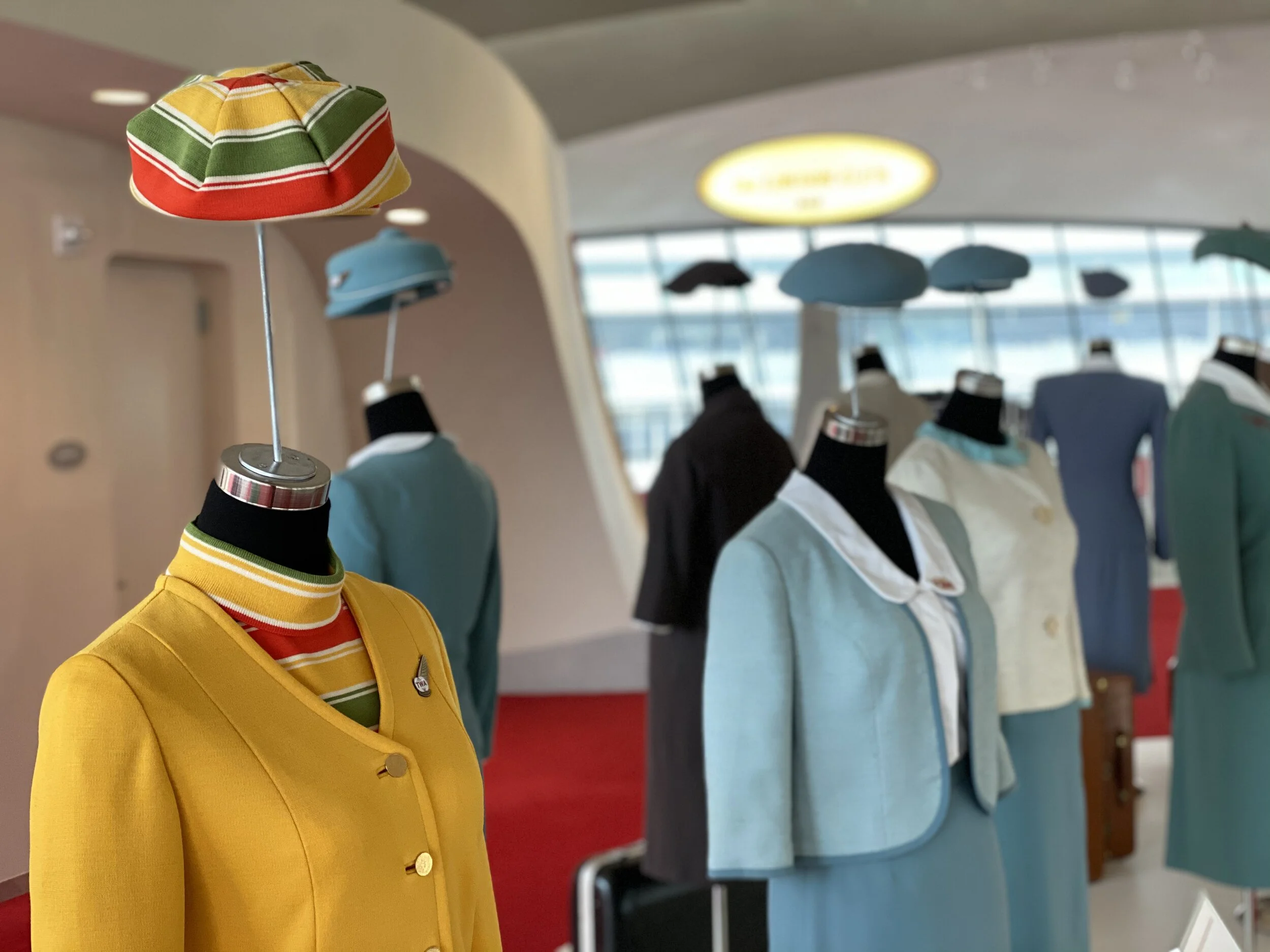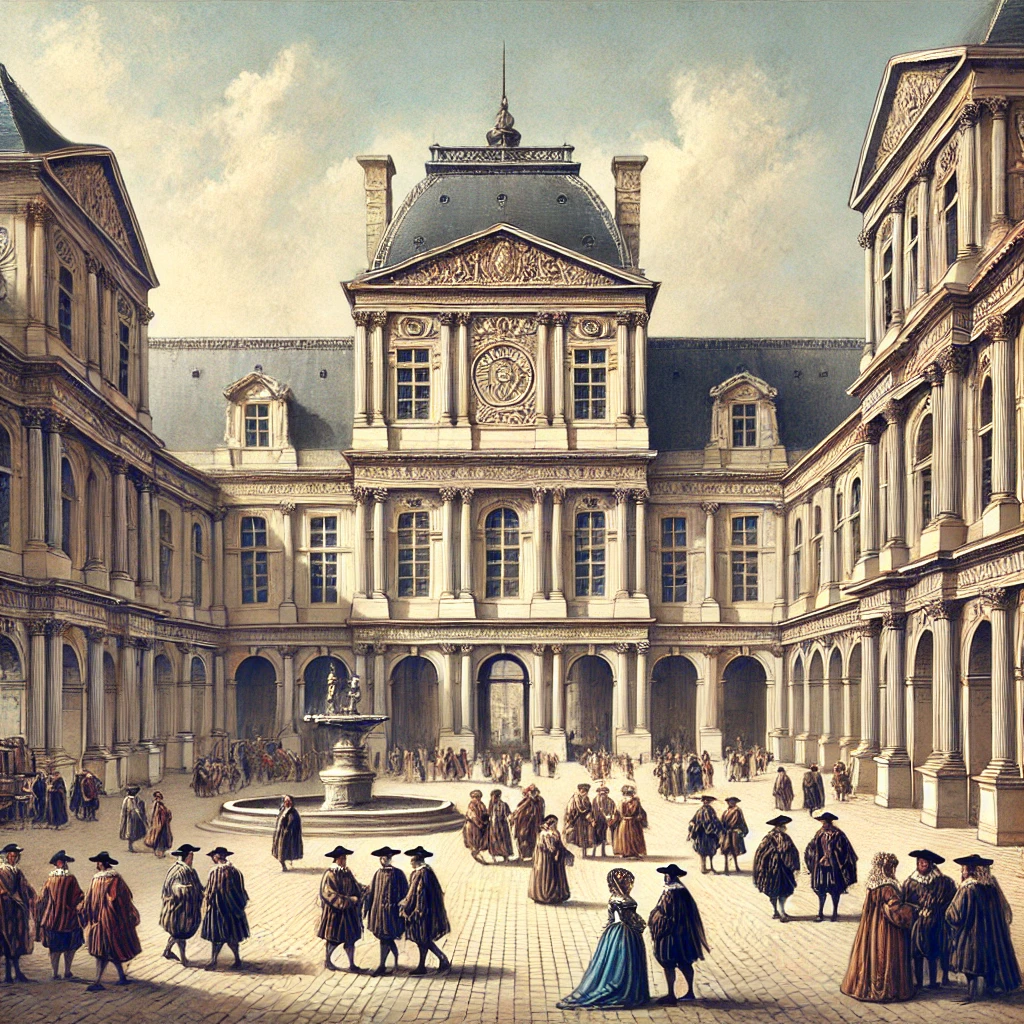Channeling the Jet Age, the Eero Saarinen-designed Terminal 5 at New York’s John F. Kennedy Airport received a second life as the lobby of the TWA Hotel.
Whether you think it looks like a bird or a sea turtle, there’s no denying the architectural excellence of the TWA Flight Center.
When I had to travel to New York to attend Shoppe Object, an independent home and gift show, at Pier 36, where I’d be assisting the Hay wholesale team with taking orders, Wally figured he’d tag along.
We flew into JFK a day early and put aside an extra hour or so to visit Terminal 5, or T5, and get a drink at the Sunken Lounge and explore the iconic Eero Saarinen-designed TWA Flight Center.
One of the first things you’ll see is this amazing check-in desk for the TWA Hotel, with the departures and arrival board (it might be old-fashioned, but it’s got up-to-date listings) and staffers in retro outfits.
“The space reminded me of Antoni Gaudí’s La Sagrada Família Cathedral in its organic sensibility.
To me, this was Saarinen’s cathedral to aviation.”
After we disembarked, we took the AirTrain to Terminal 5, then followed the signs directing us to the TWA Hotel.
Here are eight interesting facts about the TWA Flight Center.
Howard Hughes in the cockpit of a TWA plane. He bought the airline and commissioned the construction of the Flight Center.
1. Playboy Howard Hughes hired Eero Saarinen to build the terminal, costs be damned.
Prior to becoming a recluse and taking up residence of the penthouse at the Desert Inn Hotel in Las Vegas, Howard Hughes, one of the wealthiest men in the world, dabbled in motion picture direction, production and aviation. He acquired control of TWA (short for Trans World Airlines) in 1939, without ever holding an official position.
Known to want the best that money could buy, in 1959, Hughes commissioned Eero Saarinen, the Finnish-American architect behind the 630-foot-high Gateway Arch in St. Louis, Missouri, to design a terminal for the airline. Never one to keep to a budget, construction costs for the terminal ballooned from $9 million to $15 million (equal to a staggering $130 million in 2021).
An old map that shows TWA’s routes
Fun fact: Hughes was well known for his dalliances with celebrities of both sexes, including Katherine Hepburn, Cary Grant, Ginger Rogers and Olivia de Havilland.
The sky blue VW bus out front is totally groovy, man.
2. Saarinen got the inspiration for his mid-century modern marvel from a grapefruit.
Often described as a swooping bird, I found the structure to more closely resemble a sea turtle.
The TWA Flight Center was dedicated to the Golden Age of travel and was a marvel of mid-century modern design when it opened in May 1962, nearly 60 years ago — the likes of which the world had never seen.
If Eero Saarinen didn’t eat grapefruit, the TWA Flight Center would never have been conceived.
Legend has it that the architect arrived at the building’s evocative form one morning during breakfast, after flipping over a hollowed-out grapefruit rind and pressing down in the middle.
The Flight Center’s shell-shaped roof consists of four symmetrical reinforced concrete forms separated from one another by narrow skylights. Inside, undulating organic forms of the 200,000-square-foot lobby merge inward — soaring ceilings blend into walls, and those walls become floors. The space reminded me of Antoni Gaudí’s La Sagrada Família Cathedral in its organic sensibility. To me, this was Saarinen’s cathedral to aviation.
At the center of the terminal’s vaulted ceilings, the original Vulcain clock still keeps the time.
The original clock high above, positioned where the many arches converge on the ceiling
Speaking of time, Saarinen’s ran out all too soon. Sadly, the designer never lived to see his finished creation. He died at the age of 51, during surgery to remove a brain tumor, in 1961 — one year before the Flight Center was complete.
Swooping staircases and curving walkways fill the interior.
3. The media adored the TWA Flight Center, but one of Saarinen’s fellow architects described it as part of a “nightmare.”
Today, Saarinen is revered as one of the most important architects of the 20th century. However, when the TWA Flight Center opened in 1962 at what was then Idlewild Airport, not all of the attention it attracted was positive. The press was enthusiastic about his design, heaping acclaim on the structure’s dynamic form and fluid interior.
But some of Saarinen’s peers were critical of his work. British architect and critic Alan Colquhoun was quoted in Architectural Design as saying the Flight Center was “like the monster forests of a child’s nightmare, where a toadstool may be 20 feet high or like the dematerialized and unearthly forms of an Expressionist film set.”
You can understand why critic Alan Colquhoun would say the interior feels like an Expressionist film set — but why does that have to be a bad thing?
It was designated as a New York City landmark in 1994 and listed on the National Register of Historic Places in 2005.
Planes are a lot bigger than they used to be, rendering Terminal 5 obsolete.
4. The iconic terminal was ultimately too small to work for larger planes and closed for almost two decades.
By the mid-’70s, the aging hub became impractical — Saarinen’s design couldn’t accommodate the proliferation of wide-body jets that could carry hundreds of passengers at a time. The terminal was still used for smaller planes but eventually closed, with the last flight departing from there in 2001.
Duke chillaxes on the chili pepper red seating.
5. Saarinen didn’t just design the TWA Flight Center — he also created a color for it.
The signature hue, chili pepper red, which Saarinen developed for the Flight Center can be seen everywhere, from the banquettes and furnishings to the hallway carpeting in the hotel buildings. It stands out in stark contrast to the predominant white interior.
Incidentally, the space was originally outfitted by acclaimed Parisian industrial designer Raymond Loewy, the creative mind behind the 1959 TWA twin globes logo.
The Sunken Lounge as seen from the second floor
6. The Sunken Lounge is the hippest spot to grab a drink at JFK.
The centerpiece of the space is the Sunken Lounge cocktail bar, complete with Tulip chairs and pedestal tables designed by Saarinen for Knoll.
I ordered an Idlewild old fashioned, while Wally got a Bloody Mary. We were particularly delighted with the retro swizzle stick featuring a dancing Shiva, the Hindu god.
The drinks might be spendy, but the atmosphere makes it worthwhile.
Wally’s a sucker for spicy Bloodys.
There’s something comforting about the click-click-click of the retro departures board.
A split-flap departures board, by Solari di Udine, the Italian manufacturer that made the terminal’s original, displays custom messages instead of flight info. There are over 34,000 tiles on the sign, creating a nostalgia-inducing whir and clatter throughout our visit.
De plane! De plane! One imagines this aircraft was named Connie cuz she’s a Lockheed Constellation.
7. The on-site plane, Connie, is now a cocktail lounge — though she once ran drugs in South America.
While enjoying a drink in the Sunken Lounge, you can see a vintage plane through the floor-to-ceiling windows. Wally and I knew we had to explore it.
Wally’s off to see if there’s any pot left on Connie from her drug-smuggling days.
There’s no ticket needed for Duke to board this plane!
A 1958 Lockheed Constellation L 1649A — a four-propeller airplane commissioned by Hughes and affectionately known as Connie — sits parked on the tarmac behind the terminal. Its interior has been transformed into a delightful, one-of-a-kind cocktail lounge.
Grab a drink and some nibblies inside Connie, a plane-turned-cocktail bar.
Check out the cockpit while onboard Connie.
In the interim between being a part of the TWA fleet and being a star of the Flight Center, Connie engaged in some dubious activities, including delivering marijuana for a Colombian drug cartel before being abandoned in Honduras, according to Air & Space magazine.
Saarinen designed the Tulip chairs and pedestal tables found throughout the space.
8. A restoration project returned the Flight Center to its former retro space-age glory.
The impeccable attention to detail of the restoration of the former terminal was overseen by Richard Southwick, partner and director of historic preservation at New York-based architecture firm Beyer Blinder Belle.
A vintage convertible sits out front of the Flight Center.
One design element that was particularly challenging was the ceramic penny tiles specified in Saarinen’s original design. A total of 20 million custom ½-inch-diameter bisque-colored mosaic tiles were sourced and used over the course of both phases of the project, covering the floors and swooping interior walls.
The organic yet futuristic forms create a Jetsons sort of feel, retro and space age all at once.
Those things on the wall are called payphones. They’re sort of like mobiles, except they were stationary.
There’s an odd little seating area (with another classic car) off to the left when you enter.
Vintage magazines and toiletries at the newsstand by the bathroom
The upper level features a mini-museum of TWA artifacts, including flight attendant uniforms from the 1940s to the 1990s. Designs from Valentino, Cassini and Balmain are on display, along with vintage flight bags.
The Paris Café on the second floor
Famous designers like Valentino designed flight attendant uniforms for TWA. They’re on display upstairs.
The Paris Café is located on the second floor of the Flight Center and occupies the footprint of the original Lisbon Lounge.
The pair of corridors featured in the 2002 Steven Spielberg film Catch Me If You Can, starring Leonardo DiCaprio and Tom Hanks, once led to boarding gates and now offers access to the two wings of the TWA Hotel, Hughes and Saarinen, which partially encircle the terminal.
If you’ve got some extra time before or after a flight at JFK, be sure to stop by the TWA Flight Center for a drink and some photos. Saarinen’s design somehow manages to be retro and futuristic at the same time. –Duke
Follow the signs the Terminal 5, and you’ll be rewarded with the architectural and design wonder that is the TWA Flight Center.
TWA Flight Center
John F. Kennedy International Airport
JFK Access Road
1 Idlewild Drive
New York, NY 11430



